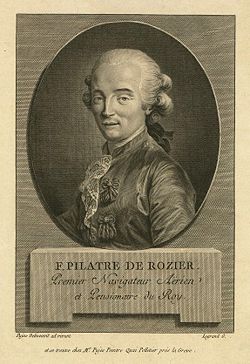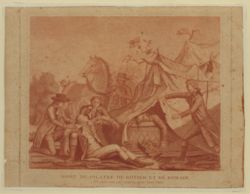Difference between revisions of "AY Honors/Hot Air Balloons/Answer Key"
| (2 intermediate revisions by the same user not shown) | |||
| Line 1: | Line 1: | ||
| − | [[Image: | + | [[Image:Pilatre de Rozier.jpg|thumb|right|250px|Jean-François Pilâtre de Rozier.]] |
| + | [[Image:Aviation fatality - Pilatre de Rozier and Romain.jpg|thumb|right|250px|Death of de Rozier and Romain.]] | ||
| − | + | '''Jean-François Pilâtre de Rozier''' (born [[30 March]] [[1754]] in [[Metz]] - died [[15 June]] [[1785]] in [[Wimereux]]/[[Pas-de-Calais]]) was a [[France|French]] [[chemistry]] and [[physics]] teacher, and one of the first pioneers of [[aviation]]. | |
| − | The | + | The son of an innkeeper, he [[botany|botanized]] in the company of the [[François de La Rochefoucauld|duc de la Rochefoucauld]], in the democratic companionship that early science fostered. His interests in the chemistry of drugs had been awakened in the military hospital of [[Metz]], an important garrison town on the border of France. He made his way to [[Paris]], then taught physics and chemistry at [[Reims]], which brought him to the attention of the king's brother, [[Louis XVIII of France|Monsieur, the comte d'Artois]], who put him in charge of his ''cabinet'' of [[natural history]] and made him a ''valet de chambre'' to Madame, which brought him his ennobled name, Pilâtre de Rozier. Soon however he opened his own museum in the [[Le Marais|Marais]] quarter of Paris, researched the new field of [[gas]]es and invented a respirator. |
| − | On [[ | + | In June [[1783]] he was present at the unoccupied [[balloon]] ascension of the [[Montgolfier brothers]]. That September he sent aloft from the front courtyard of [[Palace of Versailles|Versailles]], in an untethered balloon, a sheep, a cockerel and a duck. On [[21 November]] [[1783]] he made the first manned free flight in history, accompanied by the [[Marquis d'Arlandes]]. During the 25-minute flight using a Montgolfier [[hot air balloon]], they traveled 12 [[kilometer]]s from the château of La Muette to the [[Butte aux Cailles]] in the then [[suburb|outskirts]] of Paris, attaining an [[altitude]] of 3000 feet. |
| − | + | De Rozier died during an attempted crossing of the [[English Channel]] when his balloon, a combination [[hydrogen]] and hot air balloon, exploded on [[15 June]] [[1785]]. Thus, he and his companion, Pierre Romain, became the first known victims of an [[air crash]]. | |
| − | The | + | The modern hybrid gas and hot air balloon is named the '''[[Rozier balloon]]''' after his pioneering design. |
| − | + | [[Category:1757 births|Pilatre de Rozier, Jean-Francois]] | |
| + | [[Category:1785 deaths|Pilatre de Rozier, Jean-Francois]] | ||
| + | [[Category:Balloonists|Pilatre de Rozier, Jean-Francois]] | ||
| − | + | [[da:Pilâtre de Rozier]] | |
| − | + | [[de:Jean-François Pilâtre de Rozier]] | |
| − | + | [[fr:Jean-François Pilâtre de Rozier]] | |
| − | + | [[sv:Pilâtre de Rozier]] | |
| − | |||
| − | |||
| − | |||
| − | |||
| − | |||
| − | |||
| − | |||
| − | |||
| − | |||
| − | |||
| − | |||
| − | |||
| − | |||
| − | |||
| − | |||
| − | |||
| − | |||
| − | |||
| − | |||
| − | |||
| − | |||
| − | |||
| − | |||
| − | |||
| − | |||
| − | |||
| − | [[sv: | ||
| − | |||
| − | |||
Revision as of 19:56, 15 March 2006
Jean-François Pilâtre de Rozier (born 30 March 1754 in Metz - died 15 June 1785 in Wimereux/Pas-de-Calais) was a French chemistry and physics teacher, and one of the first pioneers of aviation.
The son of an innkeeper, he botanized in the company of the duc de la Rochefoucauld, in the democratic companionship that early science fostered. His interests in the chemistry of drugs had been awakened in the military hospital of Metz, an important garrison town on the border of France. He made his way to Paris, then taught physics and chemistry at Reims, which brought him to the attention of the king's brother, Monsieur, the comte d'Artois, who put him in charge of his cabinet of natural history and made him a valet de chambre to Madame, which brought him his ennobled name, Pilâtre de Rozier. Soon however he opened his own museum in the Marais quarter of Paris, researched the new field of gases and invented a respirator.
In June 1783 he was present at the unoccupied balloon ascension of the Montgolfier brothers. That September he sent aloft from the front courtyard of Versailles, in an untethered balloon, a sheep, a cockerel and a duck. On 21 November 1783 he made the first manned free flight in history, accompanied by the Marquis d'Arlandes. During the 25-minute flight using a Montgolfier hot air balloon, they traveled 12 kilometers from the château of La Muette to the Butte aux Cailles in the then outskirts of Paris, attaining an altitude of 3000 feet.
De Rozier died during an attempted crossing of the English Channel when his balloon, a combination hydrogen and hot air balloon, exploded on 15 June 1785. Thus, he and his companion, Pierre Romain, became the first known victims of an air crash.
The modern hybrid gas and hot air balloon is named the Rozier balloon after his pioneering design.
da:Pilâtre de Rozier de:Jean-François Pilâtre de Rozier fr:Jean-François Pilâtre de Rozier sv:Pilâtre de Rozier


